The Canton Vento 826 (right) in size and price comparison to its larger sisters 836 and 876 (sketch: Canton)
Test Canton Vento 826: so small, so good
Holger Biermann February 12, 2017
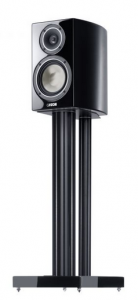
The compact box Canton Vento 826 on the matching stand LS 850.3, which costs an additional 500 euros per pair (Photo: Canton)
The Canton Vento 826 is the smallest "classic" compact box of the Vento family and is based on the
Vento 816 onwall speaker. That is, the same 16 centimeter woofer, the same 25 mm ceramic tweeter (see also
Canton Vento Family overview ) and the same height (30 cm) and width (19.5 cm) as the small 816th
But because the Canton Vento 826 is a bass reflex construction and therefore requires significantly more volume than the 816, its housing is 27 centimeters three times as deep as the deliberately flat sister.
The 826 costs 90 euros per side more than the Onwall model 816. Much of this money should be invested in the elegantly curved and painted side panels, which - as is customary for the Vento family - are built up and glued layer by layer. Like all compact boxes in the Vento series, the 826 is available in high-gloss black and white.
As a classic bass reflex box with BR port on the back, the Canton Vento 826 is best stored on a speaker stand. Canton has the very pretty and stable LS 850.3 in its range.
However, it costs another 500 euros - which maybe not everyone will do. But probably should. The LS 850.3 brings the Vento 826 tweeter to a height of around 85 centimeters. That should work well for most listening situations.
In the almost 70 square meter
LowBeats HiFi listening room , the little 826 was a little overwhelmed; with the wall-like reflectors in its back (distance: 30 centimeters), with which we can simulate smaller rooms, it sounded very balanced with a beautiful sound character even in the basic tone. And above all, extremely fine.
Even the little 816 surprised us above all with its amazing balance and richness in bass. The 826 adds a touch of looseness and "speed" to the top.
 Monty Alexander's Caribbean Circle
Monty Alexander's Caribbean Circle: Fantastic recordings by sound engineer David Chesky (Cover: Amazon)
With percussive recordings such as
"Hurricane Come And Gone" by Monty Alexander, the Canton Vento 826 works extremely precisely and wobbly due to the impulsive and detailed recording. The airiness with which the 826 reproduced the triangle was also impressive. At
Gregory Porters Live In Berlin , Porter's voice seemed to be a little more pointed than with the larger
Vento 836 , which plays a bit chubby in the basic tone.
The recording on the 826 was livelier, the voice came a little more striking. And there is another point that the Canton Vento 826 masters a little better than its sisters: Your image has something very holographic, its sound image detaches itself effortlessly from the housings compared to the larger models.
The LowBeats Sound Oracle: Compare speakers online
Like their siblings 896, 886, 876 and 836, we recorded the Canton Vento 826 in the
LowBeats listening room and archived it for the sound oracle. With these recordings, the optimal position and the same level were always maintained.
All listed Canton Vento models (but also all other
speakers tested so far at
LowBeats ) can be compared in the
Oracle sound . Try it out: with a decent headphone amplifier and good headphones you can get a very precise impression of the differences.
Conclusion: The Canton Vento 826 in a family comparison
The next, very positive surprise in the test series of the Vento family. The Canton Vento 826 convinces with the fantastic finish of its family and a sound that is rarely found in the 1,000-euro class: natural, balanced, very fine and also with some plus points compared to its larger and smaller siblings.
Compared to the smaller 816, the 826 shows the larger and more plastic image of the room and, compared to the larger 836, the faster and more agile bass. The verdict was ultimately: outstanding.
During the listening tests, we tried different amplifiers with the Vento 826. The most conclusive combination came with the equally subtle
exposure 1010 , which also fits perfectly with its price of 650 euros.
Everything about the Canton Vento series:
Test compact speaker Canton Vento 816
Test compact speaker Canton Vento 836 https://translate.googleusercontent.com/translate_c?depth=1&hl=en&prev=search&rurl=translate.google.com&sl=de&sp=nmt4&u=https://www.lowbeats.de/test-canton-vento-836-viel-bass-wenig-gehaeuse/&usg=ALkJrhiEHKbM6IYhS-fXI9QmQxe9Hr-bFg
Test floorstanding speaker Canton Vento 876 DC https://translate.googleusercontent.com/translate_c?depth=1&hl=en&prev=search&rurl=translate.google.com&sl=de&sp=nmt4&u=https://www.lowbeats.de/canton-vento-876-ueberragende-standbox-fuer-2-400-euro/&usg=ALkJrhglTXnP02_HDzjVPgmo_71KykJMyQ
Test floorstanding speaker Canton Vento 886 DC https://translate.googleusercontent.com/translate_c?depth=1&hl=en&prev=search&rurl=translate.google.com&sl=de&sp=nmt4&u=https://www.lowbeats.de/test-canton-vento-886-standbox-mit/&usg=ALkJrhiZ2V8hV4CFLdwXEnJdB4bzdeo4PA
Test floorstanding speaker Canton Vento 896 DC
Overview article Family test Canton Vento https://translate.googleusercontent.com/translate_c?depth=1&hl=en&prev=search&rurl=translate.google.com&sl=de&sp=nmt4&u=https://www.lowbeats.de/lowbeats-klang-orakel-kompaktlautsprecher/&usg=ALkJrhgaqMJmyAp1vZH_FUGYFyY00XFuJw
Background: Canton DC - more bass, less distortion https://translate.googleusercontent.com/translate_c?depth=1&hl=en&prev=search&rurl=translate.google.com&sl=de&sp=nmt4&u=https://www.lowbeats.de/canton-dc-mehr-bass-weniger-verzerrungen/&usg=ALkJrhg2yAiQXkKR5oPadeormvPQK06_mg
LowBeats sound oracle compact speaker
| Canton Vento 826 | 2017/02 |
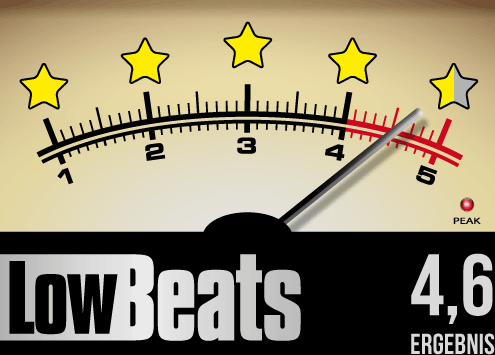 | |
| OUTSTANDING | |
rating
sound
practice
processing
total |
| The rating always refers to the respective price range. |
| | Fine, open sound |
| | Precise bass |
| | Perfect processing |
| | Excellent price / sound ratio |
Distribution:
Canton Electronics GmbH + Co. KG
Neugasse 21-23
61276 Weilrod
www.canton.de
Price (manufacturer recommendation)
Canton
Vento 826 : 1,098 euros (pair price)
The entire Canton Vento series is gathered in the LowBeats HiFi listening room. The smallest model costs 920 euros, the largest, the 896, costs 3,400 per pair (Photo: H. Biermann)
Canton Vento series - the family overview
Holger Biermann January 14, 2017
It is the most important line from Germany's most well-known speaker manufacturer: the Canton Vento series. This offers three floorstanding loudspeakers between 2,400 - 3,400 euros (pair price) and three compact loudspeakers from 920 - 1,300 euros, so it has six models in an extremely attractive price range. Reason enough for
LowBeats to compare the entire Canton Vento series.
The flagship
Vento 896 DC had its test debut in August 2016; now the smaller siblings from
Vento 886 to
816 follow. The family test not only gives a good overview of which Vento is the best in which situation - it also clarifies the question of which one of them may be slightly better than the others ...
The current Vento 6 Series is the third generation. And Vento has gotten better as it evolved. The predecessors were - in the case of the flagship - 890 and later 890.2.
Vento was introduced in 2004 parallel to the Bauhaus-style Karat series and was not only an alternative in terms of appearance. The - in contrast to Karat - wider baffle results in a little more energy in the fundamental range and because the Vento woofers are emitted to the front (and not to the side as with Karat), the placement is also less critical.
Then as now, one of the biggest differences to carat is the elegantly curved shape, which makes the case even more stable against resonance. But the process is quite complex.
Because in order to bring the housing walls into this shape, many layers of birch wood are glued to each other in the Canton joinery for each side wall, so that they can then be formed under high pressure in a press. This is a lot of manual work and usually cannot be shown in the lower price ranges. At Canton Vento, however, it is one of the hallmarks. Like the almost perfect lacquer surface.
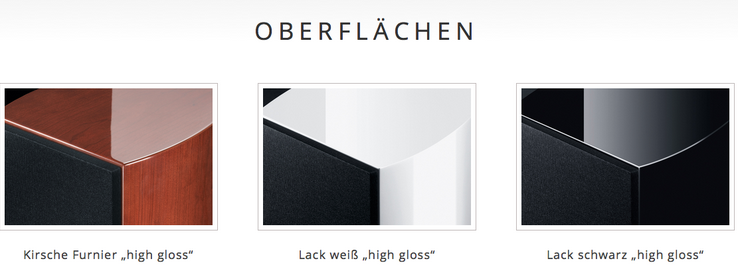
With these surfaces you can get the two large standing boxes of the Canton Vento series, the 896 8nd the 886. All others are “only” available in high gloss black and high gloss white. The paint is great, the finish almost perfect (Photo: Canton)
Another distinguishing feature are the drivers of the current 6 series, or the diaphragm clamps of the woofers and midrange speakers. Even those of the predecessors stood out due to their idiosyncratic folding.
The surrounds of the new woofers and midrange speakers are triple folded. This increases the linearity of the stroke. This is also the result of complex simulations; Canton is one of the few manufacturers in Europe that relies on Wolfgang Klippel's analysis software and hardware, who is the absolute leader in this area.
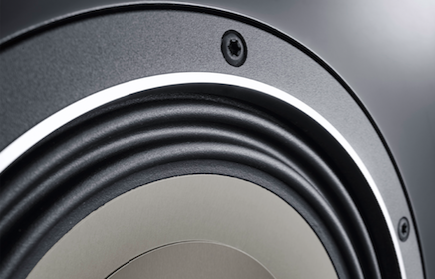
The most striking thing about the midrange and woofers of the new Canton Vento series are the tri-fold surrounds, which promise a very linear stroke. The membranes themselves are made of a composite of aluminum and titanium. The drivers are all made at the Canton plant in the Czech Republic (photo: Canton)
The bass reflex ports on the underside of the floorstanding speakers are also special. The term that has become common for this is "Downfire". This port arrangement has several advantages. First, you don't see the hole. Second: Due to the short distance to the base plate, you always have defined states. One would think.
However: The setup does not become easier with Downfire. We had to push
896 ,
886 and
876 around the
LowBeats HiFi listening room until the bass was as crisp and punchy as it should be. The compact
836 and
826 with their BR ports on the back are just a bit easier in this regard. The small 816 onwall monitor is completely uncomplicated: it has a closed housing.
12
Forward Back
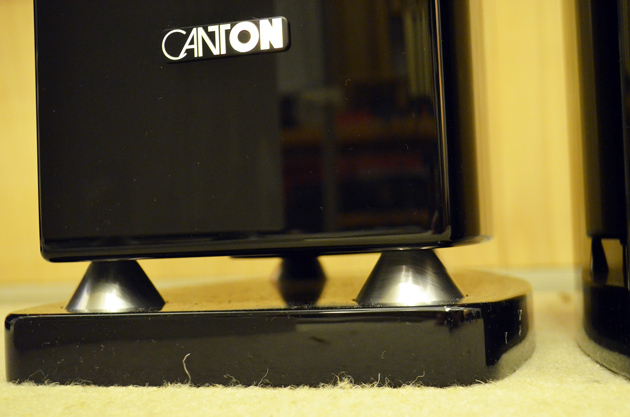
All floorstanding loudspeakers of the Canton Vento series have a base construction: Four cones keep a distance between the base plate and the housing and thus leave enough space for the air circulation of the downward-radiating bass reflex port (Photo: H. Biermann)
12
Forward Back
The Canton Vento series includes quite a few models, but the driver configuration seems clear: There is the series-typical tweeter with 25 mm ceramic dome, which is used in all models, and three basket sizes for the woofers and midrange speakers: 16, 18 and 20 centimeters.
But woofers and midrange speakers of the same size are only the same on the outside: the basses have heavy cones, the midrange speakers light. The basses have long voice coils (for a large stroke), the midrange drivers are short and light - each driver is tailored to its specific requirements. This is also an advantage if, as with Canton, the entire driver development and production is in-house.
The membranes are borrowed from the old Reference series (without "K"). It is a three-layer composite made of titanium and aluminum (hence the name "Titanium") and therefore extremely stable. The funnel in the middle is quite deep, the cone shape becomes flatter towards the outside.
This shape has the advantage that the cone is extremely strong where the voice coil starts and the inevitable bending waves are pushed further out to the edge, where they are less pronounced and cause less damage.
12
Forward Back
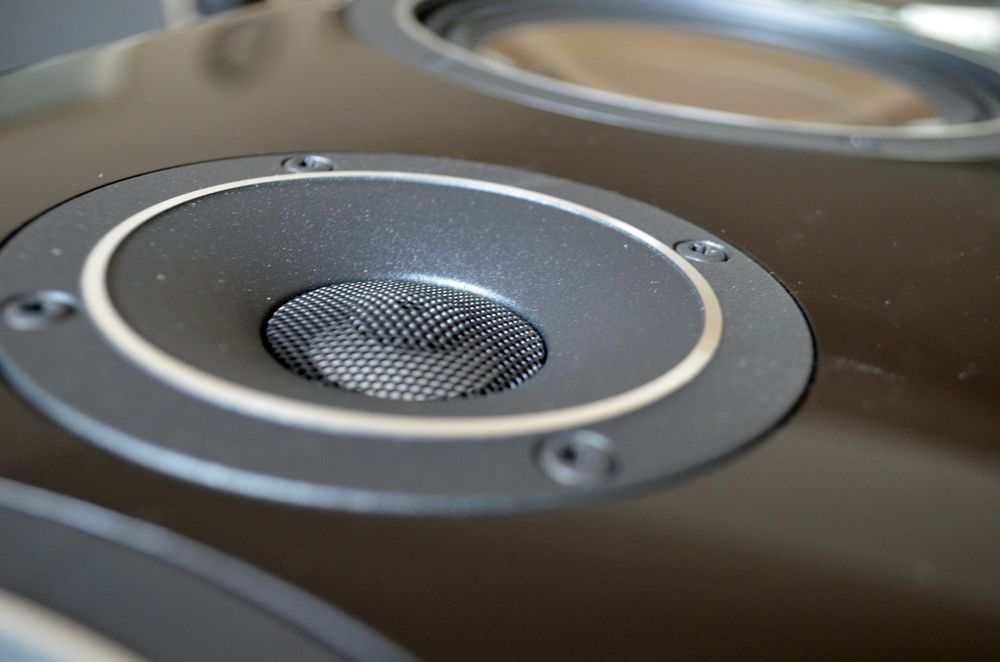
The tweeter with 25 millimeter ceramic dome ensures heights up to the smallest Vento model (Photo: H. Biermann)
12
Forward Back
At the beginning of December 2016, Canton Development
Manager Frank Göbl visited the
LowBeats editorial team to explain the special features of the Canton Vento series. This gave us deeper insights into the development processes and product strategies at Hessen. For example this: Does Canton have a separate sound for each family? Göbl: "No. We do not say yes: entry-level, so bathtub coordination.
Maybe that was the case in the past. Today I make every box as good as possible. I have my sound ideal in my head and a very special loudspeaker as a reference in the listening room. After that, I align everyone, including the Reference models. This makes every speaker as good as the material used for.
Incidentally, this change of direction also made the cheaper series more successful. ”So the greatest possible tonal family resemblance is ensured.
Canton Vento series with DC: more bass, but less risk
And then the topic of high-pass filtering, which can be recognized at Canton by the addition "
DC ". The high-pass filtering consists of a capacitor in series and a coil connected in parallel. The purpose of this construction used to be to increase the level in the (sensible) bass range and to simultaneously reduce levels in the nonsensical range - i.e. in the deep bass.
This resulted in a higher level and a higher resilience. In the past, however, the impedance often slid into dangerous areas by 2 ohms. The current Vento models are far from that. The
DC high-pass filtering still ensures higher operational reliability today, but also for a smoother impedance curve and thus for a smoother transition to the midrange, which is coupled relatively deep at 250 or 300 Hertz.
So that the impedance does not drop too far, the parallel basses are all 10-ohm models. In any case, in the
LowBeats listening room there was no problem with any of the connected amplifiers. But “DC” is a privilege of the standing boxes; the compact ones have to do without.
All Canton loudspeakers, which of course also applies to the Vento models, have a very rich, powerful bass. This is nice and usually sounds very grown-up, but requires knowledge and sensitivity when setting it up and a realistic assessment of your own domestic circumstances.
For example, if the listening room is only 18 square meters and the speakers only have space in the corner, the Vento 896 are not necessarily the best choice. In our tabular overview (which is divided into free-standing and compact
boxes ), we have included recommendations for a minimum
room size and distances to the rear wall from the experience in the
LowBeats listening room :
| Overview of standing boxes | Vento 896 | Vento 886 | Vento 876 |
| principle | 3-way bass reflex | 3-way bass reflex | 3-way bass reflex |
| driver assembly | 2 x 20 cm TT, 1 x 18 cm MT, 1 x 2.5 cm HT | 2 x 18 cm TT, 1 x 18 cm MT, 1 x 2.5 cm HT | 1 x 16 cm TT, 1 x 16 cm MT, 1 x 2.5 cm HT |
| Recommended minimum room size | 25 square meters | 20 square meters | 16 square meters |
| LowBeats installation tip | free, at least 50 cm from the wall | free, at least 50 cm from the wall | free, at least 30 cm from the wall |
| Dimensions (wxhxd) | 28.5 x 110 x 37 cm | 25 x 102.5 x 33 cm | 22.5 x 95 x 30 cm |
| Weight | 28.6 kilos | 18.0 kilos | 15.0 kilos |
And then an overview of the three compact models:
| Overview of compact boxes | Vento 836 | Vento 826 | Vento 816 |
| principle | 2-way bass reflex | 2-way bass reflex | 2-way closed |
| driver assembly | 1 x 18 cm TMT, 1 x 2.5 cm HT | 1 x 16 cm TMT, 1 x 2.5 cm HT | 1 x 16 cm TMT, 1 x 2.5 cm HT |
| Recommended minimum room size | 18 square meters | 12 square meters | 10 square meters |
| LowBeats installation tip | free, at least 30 cm from the wall | free, at least 20 cm from the wall | right on the wall |
| Dimensions (wxhxd) | 22 x 36 x 30 cm | 19.5 x 30 x 30 cm | 19.5 x 30 x 9 cm |
| Weight | 8.7 kilos | 6.0 kilos | 4.5 kilos |
The big Canton Vento hearing test
In the hearing tests, all siblings of the Canton Vento series were not bare. As advised by Canton Head of Development Frank Göbl, the tonal similarity to each other was very high, the level is enormous for all three.
The naturalness and neutrality of these boxes predestines them for any kind of music, regardless of whether it's reggae or classical: with Vento you don't go wrong. The biggest differences between the models were - naturally - in the bass, but where "a lot" does not necessarily mean "better".
My absolute favorite after many days of listening is the small stand-alone box 876 as well as the two compact 826 and 816. All three are not quite as full and powerful in the bass as the bigger siblings, but they sound finer, lighter and also wonderfully balanced.
The Canton Vento series in the LowBeats sound oracle
As usual, we also recorded all models of the Canton Vento series in the listening room and immortalized them in the
LowBeats sound oracle . There you can easily compare all Vento speakers with each other or with models from other manufacturers - provided headphones and headphone amplifiers are of high quality. And you can immediately hear that the Ventos all come from a stable. But the differences in bass are also immediately apparent.
Let us be clear: Such housing quality is very rare in this price range. And in terms of sound, the models of the Canton Vento series are absolutely capable of a majority: no special developments for special applications, but speakers that can cope with almost any music and almost any amplifier. There is hardly anything better in the sum of the properties.
The individual tests and sound files for the Vento family:
Test compact speaker Canton Vento 816
Test compact speaker Canton Vento 826
Test compact speaker Canton Vento 836 https://translate.googleusercontent.com/translate_c?depth=1&hl=en&prev=search&rurl=translate.google.com&sl=de&sp=nmt4&u=https://www.lowbeats.de/test-canton-vento-886-standbox-mit/&usg=ALkJrhiZ2V8hV4CFLdwXEnJdB4bzdeo4PA
Test floorstanding speaker Canton Vento 876 DC https://translate.googleusercontent.com/translate_c?depth=1&hl=en&prev=search&rurl=translate.google.com&sl=de&sp=nmt4&u=https://www.lowbeats.de/canton-vento-876-ueberragende-standbox-fuer-2-400-euro/&usg=ALkJrhglTXnP02_HDzjVPgmo_71KykJMyQ
Floorstanding speaker test Canton Vento 886 DC https://translate.googleusercontent.com/translate_c?depth=1&hl=en&prev=search&rurl=translate.google.com&sl=de&sp=nmt4&u=https://www.lowbeats.de/test-canton-vento-886-standbox-mit/&usg=ALkJrhiZ2V8hV4CFLdwXEnJdB4bzdeo4PA
Test floorstanding speaker Canton Vento 896 DC
Background: Canton DC technology https://translate.googleusercontent.com/translate_c?depth=1&hl=en&prev=search&rurl=translate.google.com&sl=de&sp=nmt4&u=https://www.lowbeats.de/canton-dc-mehr-bass-weniger-verzerrungen/&usg=ALkJrhg2yAiQXkKR5oPadeormvPQK06_mg
LowBeats sound oracle tower speaker https://translate.googleusercontent.com/translate_c?depth=1&hl=en&prev=search&rurl=translate.google.com&sl=de&sp=nmt4&u=https://www.lowbeats.de/lowbeats-klang-orakel-standlautsprecher/&usg=ALkJrhhsJ0nM6Yy0fHLH42TScTiSRXX-tw
LowBeats sound oracle compact speaker
Further information on the Vento series can be found on the Canton website